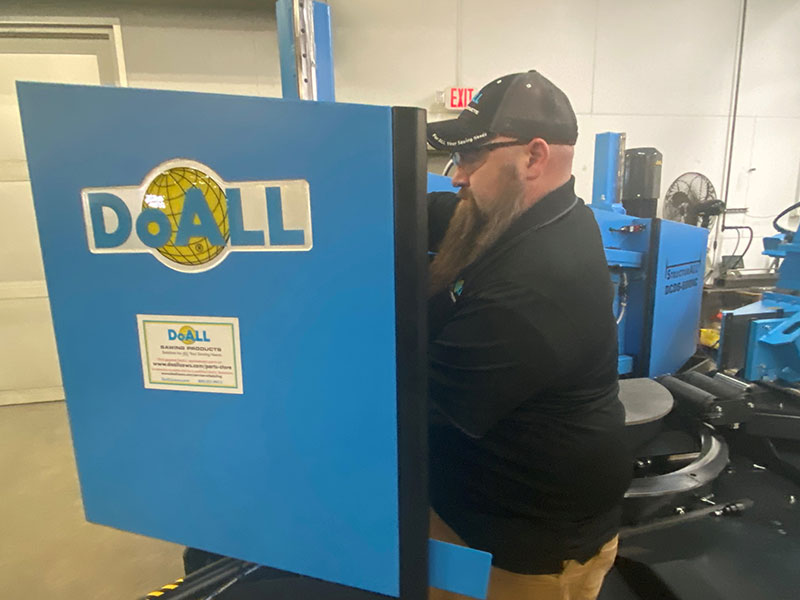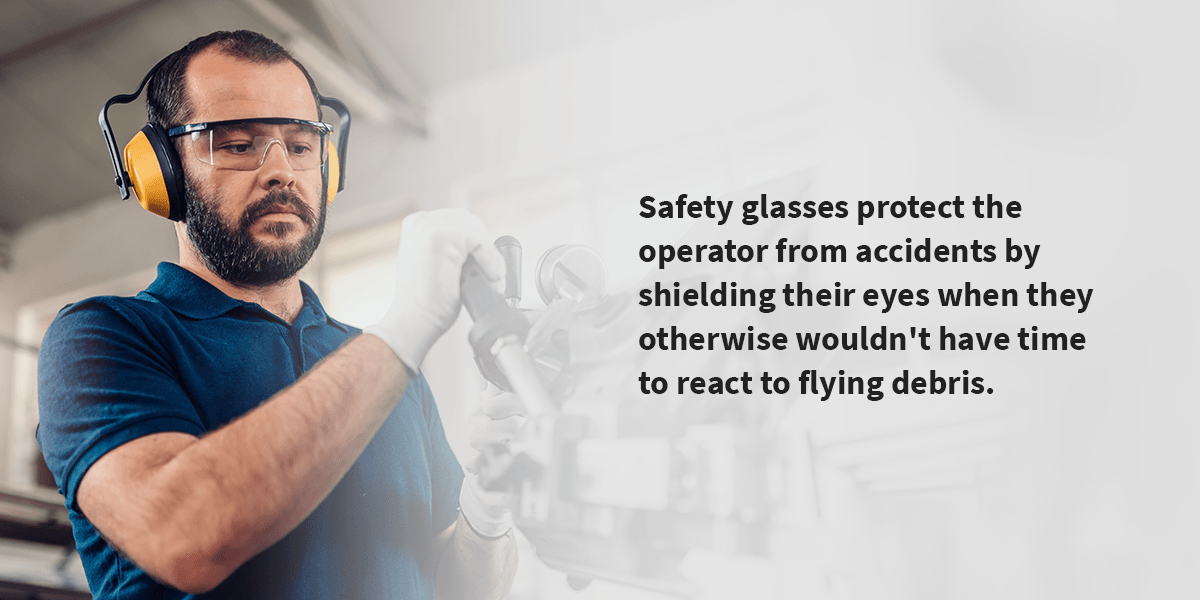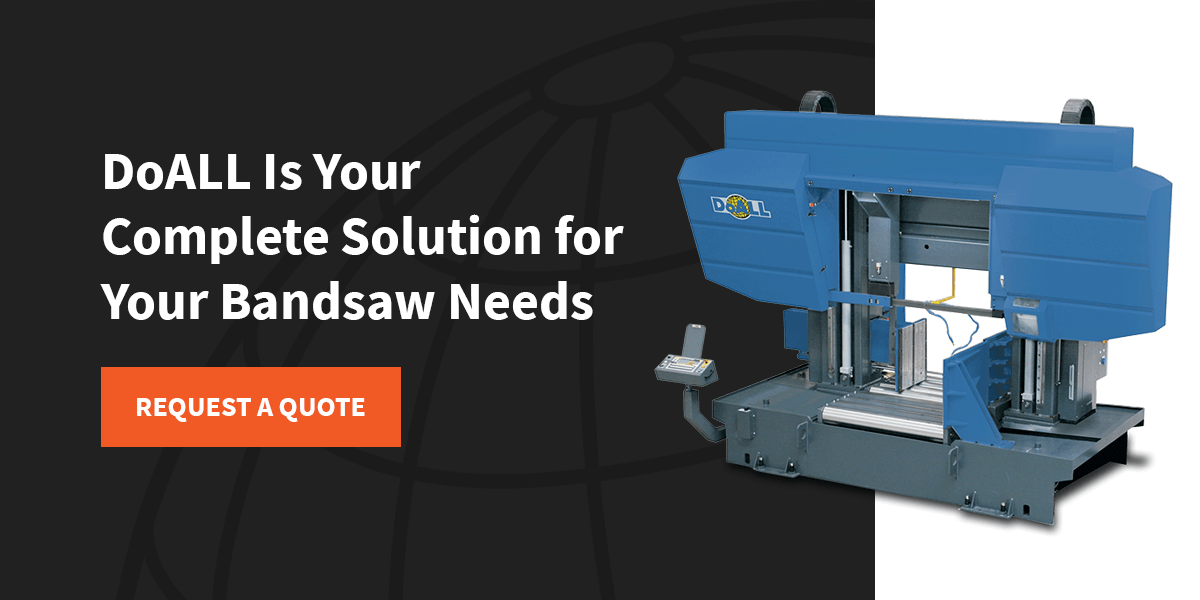How to Safely Use Bandsaws

Table of Contents
How to Safely Use Bandsaws
Bandsaws are powerful machines used in various applications and industries, from aerospace and automobile manufacturing to medical device industries and much more. These machines are efficient at cutting metal and other industrial materials into whatever shape is needed.
As with other industrial machines, bandsaws must be used properly for the best results. With a clear understanding of this tool's capabilities, parts and functions, you can learn how to use a bandsaw for your metal cutting projects.
What Is a Bandsaw?
Bandsaws are versatile machines used in metal cutting and woodworking. These machines are excellent for industrial metalworking applications because their power and precision allow you to cut regular, irregular and curved shapes.
Bandsaws consist of a long metal blade with saw teeth fixed between two wheels powered by a motor. As the wheels rotate, the blade moves continuously to make efficient cuts in your material. Industrial bandsaw machines are adaptable, with an assortment of blades you can switch out for different jobs. Most models also allow adjustment of the saw blade's exposure, cutting speed and angle.
Types of Bandsaws
Industrial metal-cutting bandsaws come in tabletop and standing varieties for different jobs. The three main types of bandsaws have different levels of operator involvement:
- Manual bandsaws: These bandsaws require you to move the material manually, increasing labor costs.
- Semi-automatic bandsaws: Semi-automatic bandsaws only require the operator to set the feed rate and blade speed and place the material — then the bandsaw makes the cuts.
- Automatic bandsaws: Bandsaws with automatic operation take the operator entirely out of the process by running on preset cut settings.
What Can a Bandsaw Do?
Bandsaws offer manufacturing and industrial professionals considerable flexibility in their metal cutting. Bandsaws can make precision cuts on materials as small as an inch or as large as 6 feet. The blades on these machines can easily cut through materials like titanium and nickel-based alloys. You can use bandsaws to cut:
- Wood
- Plastics
- Pipes
- Metal tubing
- Plates
- Solid bars
Bandsaws offer several advantages:
- Accuracy of cuts: These machines provide better visibility of the cutting line, helping operators make more efficient cuts. Bandsaws also prevent the blade from wandering during operation.
- Improved safety: Bandsaw blades cut down and hold the workpiece securely, reducing the chances of kickback.
- Increased productivity: Automatic and semi-automatic bandsaws increase productivity and efficiency by creating precise cuts.
These machines are highly useful since improved efficiency and safety ultimately extend your blade's life and reduce operator costs.
How Do You Use a Bandsaw?
These powerful machines are relatively easy to understand, yet operators must know how to safely use bandsaws before employing them on metal cutting projects. Here are some of the most crucial tips on how to use a bandsaw safely:
1. Know Your Material
Understanding your material's size and hardness is the first step to using a bandsaw. You should be familiar with your material's density and softness to determine your bandsaw's settings and blade type. Consult with your bandsaw's operating manual to determine the best settings for your job.
2. Determine the Right Settings
Cutting metal at a speed not suited for the material can cause it to warp, splinter or fly off the bandsaw. To use a bandsaw safely, determine the correct settings for your material.
Metal cutting bandsaws determine their feed by feet per minute. This number is referred to as the feed rate. Another essential metric is feed pressure, which indicates how much force the blade applies to saw materials. Follow these cutting speed rules of thumb for each type of material:
- Easy to cut: Soft metals should be cut at higher blade speeds, around 300 feet per minute (fpm) at lower feed pressure. This category includes non-ferrous materials and low-carbon steels.
- Moderately difficult to cut: Saw metals like high-carbon steels at a lower blade speed, in the range of around 200 fpm. You can increase feed pressure with these materials.
- Difficult to cut: Harder metals like stainless steel and nickel-based alloys require even lower blade speeds, around 100 fpm. These materials are cut best with greater feed pressure.
3. Use the Vice
A bandsaw's vice holds the metal in place during operation, gripping tightly to avoid movement of the workpiece. Use the vice every time you cut to maintain safe operations.
4. Keep the Blade Cool
Too much friction and heat cause bandsaw blades to warp and break. It's crucial to keep the metal and blade cool during operation. Use water-soluble coolants to reduce friction and maintain a cooler blade. A coolant should rinse the blade as it makes each cut.

Bandsaw Safety Tips
If you have a bandsaw project coming up, these additional safety tips can help you maximize your productivity and ensure safety during operation.
1. Wear Safety Glasses
The most important tip for safe bandsaw operation is to wear safety gear. During material cutting, the blade's speed can send debris and splintered metal flying. Safety glasses protect the operator from accidents by shielding their eyes when they otherwise wouldn't have time to react to flying debris.
2. Select the Right Blade
Using the correct type of blade is essential for safe and efficient cutting. Here's a brief overview of critical features to look for when selecting a blade:
Blade Material
The blade's material affects its performance. Here are a couple examples:
- Bimetal blades: These blades are made of a high-speed steel edge and spring-tempered alloyed steel back. Bimetal blades are used most widely, including in metal fabrication, as the combined materials create a highly durable tool.
- Carbide-tipped blades: This blade's tooth pockets are welded with carbide. This construction works excellently in aerospace applications cutting nickel and titanium.
Tooth Geometry
Your blade's teeth determine its cut quality and efficiency and impact blade life. Take a look at the three most common tooth types:
- Hook tooth blades: These teeth are more widely set and closely spaced. They are ideal for cutting non-ferrous metals and plastics.
- Wavy and raker-set tooth blades: This blade is often used to cut ferrous metals.
- Skip tooth blades: Skip tooth blades are widely spaced and provide excellent chip clearance. This tooth style is best for softer metals.
Always check the packaging to determine if a blade is made for the material you will be cutting.
3. Break Your Blade In
New bandsaw blades have very sharp teeth that can break off. Conditioning your blade at the beginning of its life dulls the teeth enough to help prevent damage later.
To break in your blade, start with a bit of pressure and gradually increase it, depending on your material type. For softer metals, use a break-in pressure that's 50% of the normal feed pressure for the first 50 to 100 square inches. With harder materials that are more difficult to cut, you can use a break-in pressure of 75% of the normal feed pressure for the first 25 to 75 square inches.
4. Maintain Your Bandsaw Properly
You can do a lot to maintain your bandsaw and increase safety when operating it, including the following:
- Replace throat plates often: Bandsaw throat plates prevent splinters from wedging inside the blade and jamming its movement. Replace throat plates regularly, especially if they are damaged.
- Adjust your blade guards: A bandsaw's blade guard should be right above the cutting material to prevent unnecessary tension on the blade. Adjust your blade guard on each cut for optimal performance.
- Clean blades regularly: Clean your blades monthly at a minimum, although biweekly or even more frequent cleaning can be better. Use oven cleaners, rust removers or degreasing agents to remove resin and grime.
DoALL Is Your Complete Solution for Your Bandsaw Needs
If you need bandsaws, blades and coolants for your industrial material cutting applications, DoALL Sawing Products is your complete solution. We provide high-quality products and exceptional support to help you find solutions for ALL your sawing needs.
Our staff's professional knowledge can help you determine the specific solution for your individual needs. We also offer the DoALL Cut Above 10-year warranty to help your team stay a cut above the competition. Request a quote today or browse our selection of bandsaw machines online.

